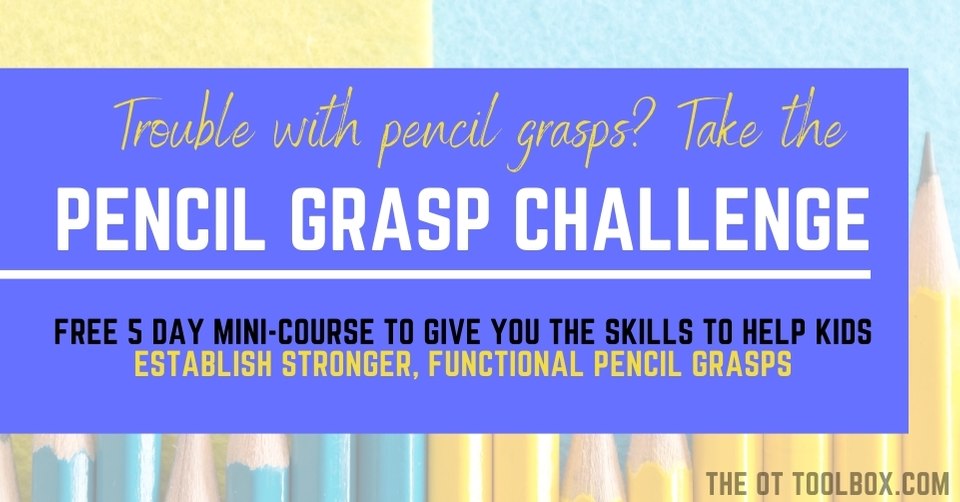Pencil grasp development is a common concern for many parents, teachers, and therapists. So often, we see children holding a pencil with all of their fingers wrapped around the pencil, or very awkward pencil grips and wonder what is a typical pencil grasp. But, did you know that children typically progress through pencil grasp development in a predictable pattern? It’s true! Let’s talk pencil grasp.
First, when it comes to writing with a pencil, there are a few things that therapists want parents to know about pencil grasp.
Secondly, it’s important to note that grasp development, while it can be predictable, can also vary in timing. And when grasp doesn’t follow the progression listed below…it can be ok! In fact, a functional pencil grasp is perfectly fine for children.
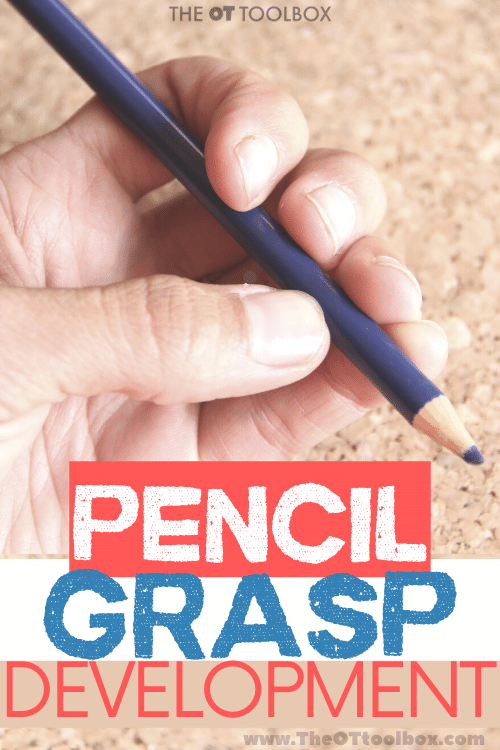
Pencil Grasp Development
Grasp development follows three main categories: primitive grasps, transitional grasps, and mature grasps.
Primitive Pencil Grasps
In this beginning pencil grasp, the whole arm moves the pencil. These grasps include two specific grips which are described below:
- Palmer Supinate Grasp (a whole hand grasp)
- Digital Pronate Grasp
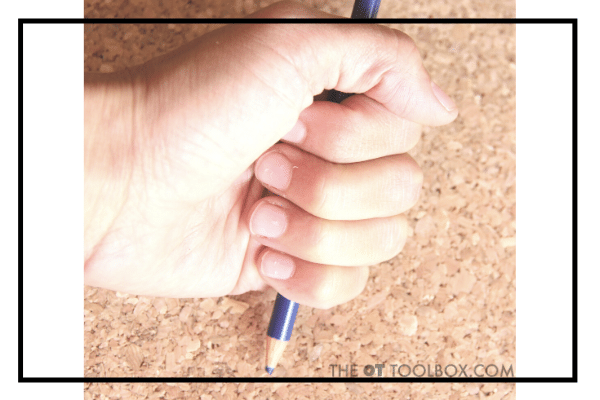
1. Whole Hand Grasp/Palmer Supinate Grasp- (Typically seen between 12 months-1.5 years) Child holds the crayon with their whole hand, with the writing end of the crayon sticking out near their pinkie side of the hand. It looks like they are holding a paint stirrer or potato masher.
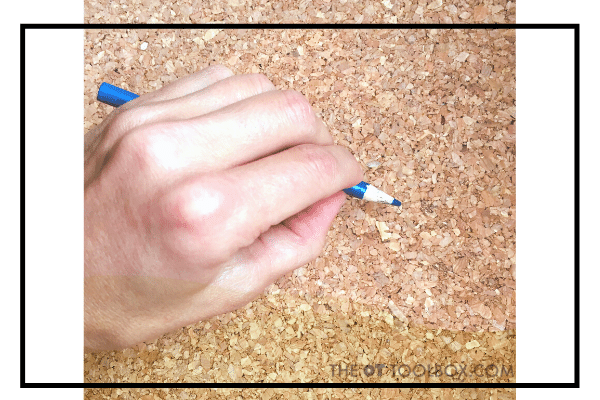
2. Digital Pronate Grasp/ Pronated Wrist Grasp- (2-3 years) Crayon is held in the hand so the tip of the crayon (or the drawing end) is held on the thumb side of the hand.
Transitional Pencil Grasps
In the transitional pencil grasp stage, the child’s forearm and/or wrist moves the pencil.
Transitional Pencil Grasps include:
- Quadrupod grasp
- Static Tripod grasp
- Other grasp patterns
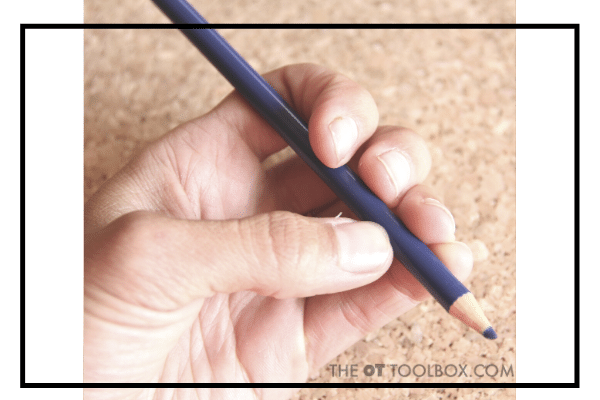
1. Quadrupod Grasp, or Four Fingered Grasp- (3-4 years)- Crayon is held between their thumb, and tips of the pointer finger, middle finger, and ring finger. As the child progresses, these four fingers may pull down to the tip of the finger into a quadrupod grasp.
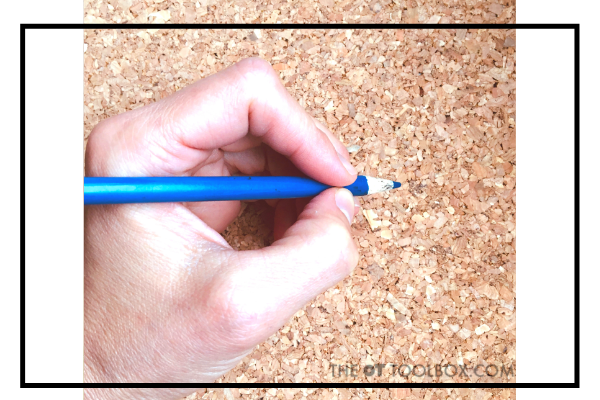
2. Static Tripod Grasp- (3.5-4 years)- Child holds the writing utensil with the thumb, pointer finger, and rests the utensil on the last joint of the middle finger. The ring finger and pinkie fingers are tucked into the palm of the hand.
3. Other grasp patterns- There can be many variations of grasp patterns that occur in the transitional stage, marked by the use of the wrist or forearm to move the pencil.
Mature Pencil Grasps
In the mature pencil grasp stage, the child holds and maneuvers the pencil using mobility in the fingers or the hand.
Mature grasp patterns include:
- Dynamic Tripod Grasp
- Lateral Tripod Grasp
- Dynamic Quadrupod Grasp
- Lateral Quadrupod Grasp
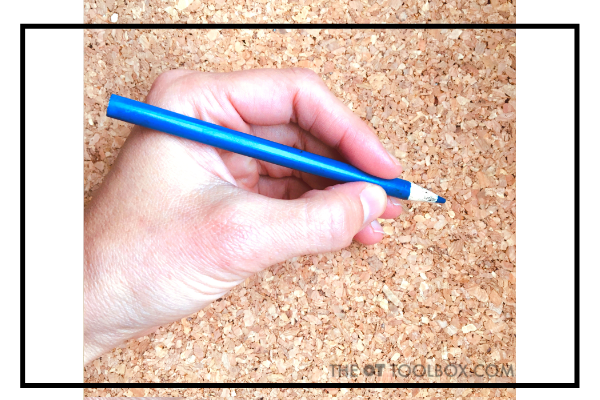
1. Dynamic Tripod Grasp- (4-6/7 years) Thumb and pointer finger hold the pencil as it rests on the last joint of the middle finger. Pencil movements occur via manipulation of the fingers and hand. Note that a true dynamic tripod grasp may not be established up until around 14 years of age.
2. Lateral Tripod Grasp- Thumb is pressed in against the pencil (or adducted) to hold the pencil against the side of the pointer finger. The tip of the thumb may bend over (or flex) over the pencil in a “wrapped” position. This grasp is sometimes called a thumb wrap grasp because the thumb is not involved with the distal movement of the pencil. Distal mobility occurs, but it is the index and middle fingers manipulating the pencil.
3. Dynamic Quadrupod Grasp- Grasp is similar to the dynamic tripod grasp, but opposition includes the thumb, pointer finger, middle finger on the pencil shaft.
4. Lateral Quadrupod Grasp- Grasp is similar to the lateral tripod grasp, with its thumb wrapped positioning of the thumb, but uses the pointer, middle, and ring fingers are on the pencil shaft and manipulate the pencil.
Quadrupod Grasp
One thing that is important to mention is the quadrupod grasp. You might have noticed this term was mentioned a few times above, and in difference areas of development through the progression of pencil grasp development.
The quadrupod grasp is considered a four finger grasp, in which four fingers (thumb, pointer finger, middle finger, ring finger) are used to hold the pencil. Quadrupod grasp progresses from a static form to a dynamic form where there is fluid motion and repositioning in the joints of the hands.
Quadrupod Grasp- If the thumb opposes the pointer finger, middle finger, and ring finger this may be called a quadrupod grasp. A quadrupod grasp can also occur with the pencil resting on the side of the ring finger.
The quadrupod stage is an important part of grasp development as the fingers move into a dynamic position with pronation and extension of the wrist. However, don’t get stuck on a quadropod grasp if this type of grip is used with older children or if students are established with their quadrupod grasp!
Quadrupod grasp or Tripod Grasp?
Research tells us that the quadrupod grasp is a very functional grip and the use of one extra finger (as opposed to the traditional sense of a tripod grasp) is actually very functional in written work.
Some may say that the quadrupod grasp is more restrictive than the tripod grasp, however that extra stability can actually promote more mobility in the pencil and be used in very efficient and effective handwriting.
When the child that the uses a quadrupod grp on the pencil is forced to use a tripod grasp, you may see a decrease in written work legibility due to decreased stability. The arches of the hands may need to compensate for strength and dexterity in the fingers and that precise placement that the ring finger adds to the shaft of the pencil just isn’t as targeted with the arches of the hand and the stability offered through the ulnar side of the hand. For those who have the stability in the ulnar side and within the arches or intrinsic muscles, a tripod grasp can be more precise and lead to more refined pencil motions.
So you can see that it all is up to each individual when it comes to forcing a student to move from quadrupod to tripod. It just may not make sense to do so for some…and that’s ok and very functional!
Other Functional Pencil Grasps
There are other grasps that can be considered “functional” in which the child holds the pencil differently than described here, but can also write in an efficient manner.
These can include (but not be limited to) a thumb wrap grasp, thumb tuck grasp, inter-digital brace grasp, or a finger-wrap grasp.
How to help with pencil Grasp
Want to know more about pencil grasp progression, development, and strategies to use to help children build a strong, efficient, and functional pencil grasp? It’s all in the Pencil Grasp Bundle!

The Pencil Grasp Bundle is for those struggling to help students with carryover of skills. It’s designed to make pencil grasp practice meaningful and motivating. The Pencil Grasp Bundle is 16 pencil grasp resources, guides, worksheet sets, and tools.
Pencil Grasp Success Was Never Easier.
- It can be a real struggle to help kids address tricky pencil grasps.
It is frustrating and difficult to weed through all of the information and pull out what will work for a child. - You struggle with kids who work on skills but can’t carryover handwriting and pencil grasp into the classroom.
- Therapists may search for fresh ideas to address pencil grasp needs and wonder whether a grasp is considered functional or needs changing.
- Therapists need pencil grasp screening and educational materials to address a huge influx of therapy referrals.
- Parents wonder about development and skills.
- Teachers will love the Centers activities to incorporate into learning to impact carryover of handwriting skills.
The Pencil Grasp Bundle includes 16 products and is valued at over $73. It’s bundled together and offered at just $24.
More pencil grasp help
Want to know how to fix a problem with pencil grasps? Need help knowing where to start when it comes to immature pencil grasps or a child hating to write because their hand hurts? The Pencil Grasp Challenge in open for you! In this free, 5 day email series, you’ll gain information, resources, specific activities designed to promote a functional, efficient pencil grasp.
The pencil grasp challenge is a free, 5 day mini course and challenge. During the course of five days, I’ll be teaching everything you need to know about the skills that make up a functional pencil grasp. You’ll learn what’s going on behind the inefficient and just plain terrible pencil grasps you see everyday in the classroom, clinic, or home. Along with loads of information, you’ll gain quick, daily activities that you can do today with a kiddo you know and love. These are easy activities that use items you probably already have in your home right now.
Besides learning and gaining a handful (pun intended) of fun ideas to make quick wins in pencil grasp work, you’ll gain:
- 5 days of information related to pencil grasp, so you know how to help kids fix an immature pencil grasp.
- Specific activities designed to build a functional pencil grasp.
- Free printable handouts that you can use to share with your team or with a parent/fellow teachers.
- You’ll get access to printable challenge sheets, and a few other fun surprises.
- And, possibly the best of all, you’ll get access to a secret challengers Facebook group, where you can share wins, chat about all things pencil grasp, and join a community of other therapists, parents and teachers working on pencil grasp issues.
Click here to join the Pencil Grasp Challenge.

Colleen Beck, OTR/L has been an occupational therapist since 2000, working in school-based, hand therapy, outpatient peds, EI, and SNF. Colleen created The OT Toolbox to inspire therapists, teachers, and parents with easy and fun tools to help children thrive. Read her story about going from an OT making $3/hour (after paying for kids’ childcare) to a full-time OT resource creator for millions of readers. Want to collaborate? Send an email to contact@theottoolbox.com.


